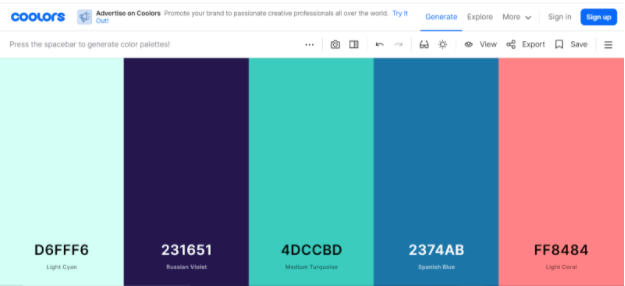Blitz News Digest
Stay updated with the latest trends and insights.
Color Your World: Choosing the Right Palette for Your Website
Transform your website with the perfect color palette! Discover tips and tricks to captivate your audience and boost engagement today!
The Psychology of Color: How to Choose the Right Palette for Your Website
The psychology of color plays a crucial role in how users perceive your website, influencing their emotions and behavior. Different colors evoke different feelings and associations; for instance, blue often conveys trust and professionalism, making it a favorite among corporate websites. In contrast, red can create a sense of urgency or excitement, ideal for calls to action. When choosing a color palette, consider your target audience and industry norms. A well-thought-out color scheme not only enhances your brand image but also improves user experience by guiding visitors through your content effectively.
To select the right color palette for your website, start by understanding the emotional impact of various colors. Consider creating a color wheel to visualize potential combinations. Here are some tips to keep in mind:
- Identify your brand's personality: Choose colors that reflect your brand values.
- Limit your palette: Stick to 2-4 main colors to maintain consistency and avoid overwhelming visitors.
- Test your choices: Use A/B testing to see how different colors affect user engagement and conversions.

Top 5 Color Combinations That Boost User Engagement
Color plays a crucial role in web design, influencing user emotions and behaviors. In this blog post, we will explore the top 5 color combinations that boost user engagement. Implementing these combinations can enhance the visual appeal of your website, making it more inviting and effective in retaining visitors. Let's dive into the vibrant world of colors and how they can improve your site’s overall performance.
- Blue and Orange: This dynamic duo captivates attention while providing a refreshing contrast. Blue instills trust and calmness, while orange adds excitement and energy, creating a balance that encourages users to explore further.
- Green and White: Associated with nature and tranquility, green evokes a sense of peace, complemented perfectly by white's simplicity. Together, they create a clean and inviting atmosphere that fosters user interaction.
- Red and Yellow: A classic combination that radiates enthusiasm and urgency. Red catches the eye, while yellow adds warmth, making it perfect for calls to action.
- Purple and Gold: This rich pairing signifies luxury and creativity, making it ideal for brands that want to convey sophistication.
- Black and Cyan: This bold contrast draws attention and creates a modern aesthetic that appeals to a tech-savvy audience.
Are You Using the Right Colors? Common Mistakes in Web Design
Choosing the right color palette for your website is crucial in shaping user experience and brand perception. Many web designers fall into common pitfalls, such as using too many contrasting colors that can overwhelm visitors or choosing colors that do not align with the brand’s identity. Common mistakes like these can lead to confusion and a lack of trust, ultimately driving potential customers away. It is essential to focus on color harmony and the psychological impact of colors, ensuring that your website communicates the right messages effectively.
Another frequent error is neglecting accessibility standards when selecting colors. For example, using a light text color against a light background can make your content virtually unreadable. This not only frustrates users but can also violate web accessibility guidelines. Remember to test your color combinations for contrast ratio to enhance readability. Tools are available that can help evaluate your color choices, ensuring that your website is inclusive and user-friendly. Prioritizing these aspects will help you avoid the common mistakes that can hinder your site's success.